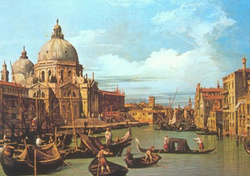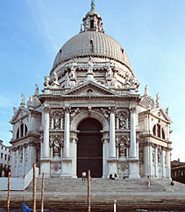|

Eleven architects took part in the competition to build the church
and the winner was Baldassarre Longhena.
His design perfectly captured the grandiosity and magnificence that
the Serenissima wanted: a church that exalted the Holy Virgin and
the Republic at the same time. The round design (an absolute
novelty) symbolised the Madonna’s crown and was also a metaphor
for virginity, and these images were extended to the city.
The first stone was laid with the plague still raging through the
city and the church was consecrated in 1687.
|
| |

From an urban and scenic viewpoint, the enormous church, situated
where the Grand Canal flows into Saint Mark’s Basin, served
to counterbalance the awesome domes of Saint Mark’s Basilica
and further embellish the landscape.
|
|

It is a church with a central plan, covered by a huge dome supported
by imposing buttresses.
Externally the octagonal design is distinguished by architectural
perspectives, the most grandiose of all being the main facade with
its impressive portal, emphasised by the wide stairway leading to
it.
|
|
|
|
|
The interior is both sober and majestic, with solid
archways divided by composite columns. |
| Above the opulent main altar is a marble group depicting
Venice kneeling before the feet of the Madonna and begging her for
protection. Also at the main altar is an image of the Virgin from
the 13th century Greek-Byzantine school. |
|
|